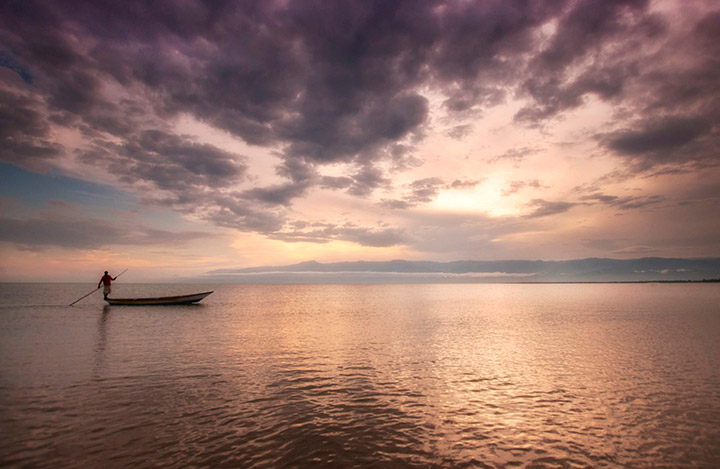The highlands of Ethiopia are the stuff of fairy tales, mystical and utterly unexpected. Dale Morris has two exquisite wildlife encounters he’ll never forget for the rest of his life.
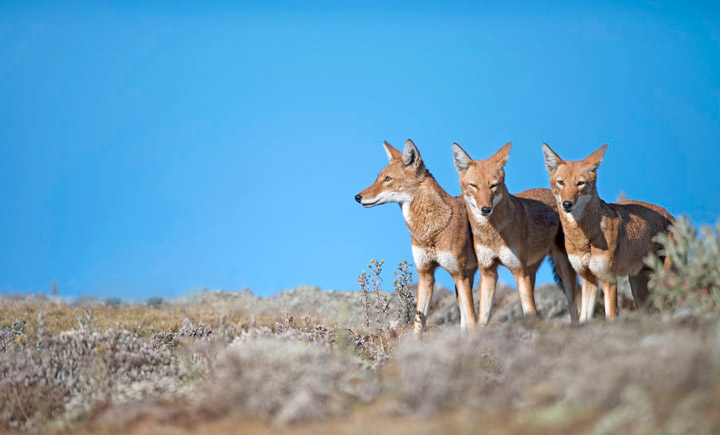
A trio of easily sighted yet paradoxically rare Ethiopian wolves atop the Sanetti Plateau. Wolves have been able to cling onto existence due to the isolated nature of their preferred habitat, combined with the fact that they subsist mostly off rodents, which are plentiful in the Bale Mountain highlands.
The Ethiopian wolf
I can’t feel my fingers for the cold. I’m standing in snow, and sleet is stinging my face. But despite the uncomfortable temperature, I’m in raptures. Just 20 metres from my feet are a pair of wolves. One is stalking like a leopard, its body held low, ears flattened back. The other is standing bolt upright, further away, but clearly visible to its target: a rabbit. My heart is pounding now, partly because here on the Sanetti Plateau it’s 4 000 metres above sea level and the air is so thin that the slightest exertion is exhausting. Mostly, though, it’s because of the hunt.
Wolf A, a beautiful creature with rusty tones and glistening eyes, backs off slightly, away from the rabbit. He is lying, of course, telling his prey, ‘I don’t see you.’ The rabbit, still as the rock against which it believes it’s concealed, watches the wolf, nose quivering, fearful.
And then, fast as lightning, it happens.
Wolf B springs up from beneath a shrub, surprising the rabbit, making it bolt without thinking. Wolf A takes it down.
‘Wow! That was something,’ Sultan Kaedir hisses from the relative warmth of our 4×4. He’s parked a few metres away on the only road in the Bale Mountains. The wolves are gone now. They vanished within seconds of devouring their food, leaving me standing breathless, shivering and awed. I once read that Ethiopian wolves are not only the rarest of all the world’s 37 canids, but are also one of the world’s rarest animals, period.
‘Just 450, we think,’ says Sultan, a wolf tracker with the Ethiopian Wolf Conservation Programme. ‘But here on the Sanetti Plateau, they are easy to see.’

A wolf slinks through a landscape of silvery flowers, using a keen sense of smell and hearing to locate its prey.

There’s little in the way of biodiversity on the freezing upper reaches of the Bale Mountain highlands, but tropical jungles dominate in the steamy lowlands and here you’ll find thousands of plants, insects and fungus species.
The Bale Mountains
The Bale Mountains of southern Ethiopia do not yet feature heavily on Africa’s tourist map despite their awesome appearance and high levels of endemic animals. Like most high mountain ranges, they are stratified with an array of startlingly different habitats, all of which are magical in their own right. The lowlands are carpeted in tall cloud forests where black leopards have been seen, and endemic Bale monkeys share their treetop domain with touracos and silvery cheeked hornbills.
Higher up, you pass through a belt of moss- and mist-shrouded woodland called the juniper forests, where gnarled and twisted trees conjure up childhood memories of dark fairy tales. Further up still is a fynbos-like habitat, and then, at 3500 metres and above, you’ll reach a beautiful plateau of afro-alpine moorland. This is where you’ll find the wolves, hunting mice and mole rats among oddly shaped lobelia plants, swirling clouds and dense silvery shrubs.
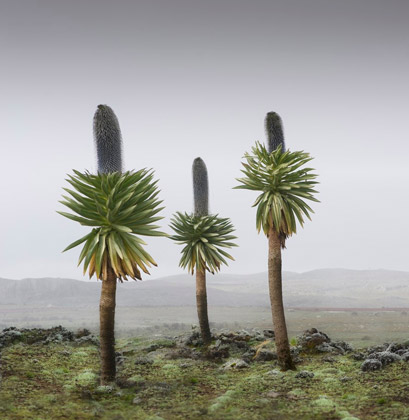
The only plant hardy enough to grow tall in the Bale Mountain highlands are these giant lobelias – they are endemic and able to survive being frozen solid. After 10 years or so, they produce a column of flowers (as these are doing) and then die.

Looking into the heart of a giant lobelia plant atop the plateau of Bale Mountains National Park.
But Bale is not only about wolves. Harenna Forest is so mysterious that whenever a science team goes in there, they invariably come out clutching a list of brand-new species.
Huge trees, encrusted with mosses and ferns and flush with tropical birds, throw their shade over a spidery network of hiking trails. There are waterfalls and mountain viewpoints to walk to, and quite a few avian endemics to find. It was the newly discovered Bale Mountains vervet that was top of my list. I’d heard them chattering and seen the remnants of their bamboo meals littering the forest floor, but the most I’d seen of these monkeys was a fleeting glimpse of a bottom and a tail.
It seemed churlish to be disappointed. Colobus monkeys, beautiful birds, mountain nyala, bush pigs and handsome scenery were all to be seen aplenty. Ethiopia is full of unique wildlife experiences like these. The nyala are endemic, as are the Menelik’s bushbuck, blue-winged geese, yellow-fronted parrots, Harwood’s francolins, wattled ibis and a list as long as your arm of other birds, reptiles and amphibians.
It’s a truly amazing place, so why so few tourists?
It’s always been a schlep to get to Bale Mountain National Park. It’s some 400 kilometres southeast of Ethiopia’s capital city, Addis Ababa, over a rough road that ends in atrocious accommodation options. Hardy backpackers who don’t mind staying in run-down hotels or outdated tents in sub-zero temperatures go for the R40 options, but those with more discerning tastes have had nothing to choose from. But now there’s the recently opened Bale Mountain Lodge, an upmarket, all-inclusive hotel set among towering trees in the Harenna Forest section of the park. It’s here that I stayed, taking advantage of the easy access to the highland plateau less than an hour’s drive away.
But for the ultimate animal encounter, you have to head to the north, to the towering cliffs and precipitous plummets of the mighty Simien Mountains.
Drakensberg on steroids
Imagine yourself, if you will, sitting on an undulating plain as green and manicured as a golf course. This idyllic ‘garden’ terminates at a cliff edge that drops more than a kilometre straight down. If you fell, chances are you could whistle your favourite tune in its entirety before hitting the ground. These are the Simien Mountains, a Unesco World Heritage Site and a place of dizzying peaks and ragged canyons that can best be summed up as the Drakensberg on steroids.
Your attention has, until now, been taken up by a small cluster of the incredibly rare walia ibex, a long-horned mountain goat found here in the Simien Mountains and nowhere else on Earth. The males, arrogant and proud, fill the air with the percussion of their knocking horns. A pair of bearded vultures circle overhead.
Then, suddenly, a horde of hairy beasts pours forth from the lip of the cliff and pushes on towards you like an advancing army. There’s literally hundreds of them. The mountain winds send their shaggy coats into disarray. The field fills up with chattering monkeys, with more still coming, spilling out onto the greenery like an endless river of hair and teeth and colour. The ibexes keep up their head butting and pay the swarm no heed.

The giant grazing gelada baboon is the last of its kind. Once there were many species of cow-like primates wandering Earth’s open grasslands, but now the only place you will find them is the Ethiopian highlands.
It’s alarming at first. After all, gelada baboons have the largest canines of any primate, yet they are peaceful. Within moments you are surrounded on all sides. Pinned in. Unable to move.
‘I think this group is about 500 strong,’ my guide from Simien Lodge tells me, ‘but I’ve seen bigger.’
I’m flabbergasted. Geladas are the last of their kind; a remnant species from a group of grass-eating monkeys that once dominated the continent. Basically, they are the cows of the Simiens, spending their entire day marching across the highlands grazing on shoots.
In Simien Mountains National Park, there is a rule that says you must not approach a gelada to within two metres. It’s for their sake rather than yours. But there’s not much to be done about it when you are sitting among them, as I was, and the throng encircles you.
They plonk down next to you, sidle up beside you, nudge against you, their adorable babies cartwheel right over your legs. You don’t really exist in their eyes, so intent are they on socialising and grazing. And like all monkeys the world over, they are busy, busy beasts. There are big males sparring and crèches of fuzzy youngsters; there’s politicking and bluster. It’s an amazing experience – and what made it even better was that my guide and I were the only two people there.
Environmental snapshot
Ethiopia has 15 national parks and nature reserves and human encroachment is a major problem in almost all of them. Ethiopian wolves were common and widespread as recently as the mid-19th century, but not so today. Now they are found only in certain fragmented highland regions. In Bale, pastoralists take their cattle and dogs to the highest reaches of the park, spreading diseases such as rabies and distemper to the wolves. The Ethiopian Wolf Conservation Programme has a highly effective vaccination project in place, yet rabies outbreaks still occur. In 1991, an epidemic killed around 75 percent of the population. Hybridisation with domestic dogs is also a serious problem.
The plight of the ibex of the Simiens is similarly dire. Hunting and habitat loss caused their numbers to plummet to under 200 but recent conservation efforts have allowed for a gradual comeback. There are now about 600 in the park.
Although not officially endangered, gelada baboons must compete with tens of thousands of people who reside within the boundaries of Simien Mountains National Park. Crop raids are common as is human retribution despite laws prohibiting the killing of monkeys.
Despite all this, there is great hope for Ethiopia’s beleaguered wildlife thanks to a valuable growth in ecotourism. Tourism-related profits are being channelled into conservation efforts and the government, although apparently apathetic towards wildlife, may well change its focus in the face of growing international attention.
Find more information at ethiopianwolf.org and www.simienmountains.org.
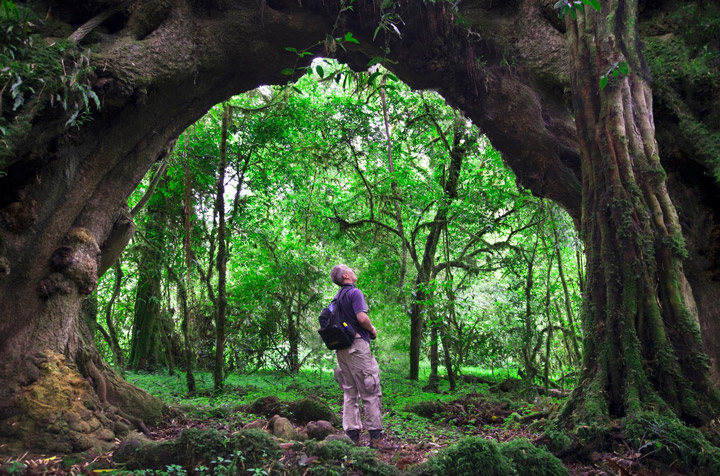
The Harenna Forest that encircles the Bale Mountains is one of the world’s least explored habitats – giant trees, festooned in epiphytic ferns and mosses, offer sanctuary to many endemic bird species as well as countless insects which are as yet unknown to science.

A troop of colobus monkeys, easily encountered in the Harenna Forest.

A bushpig snuffling for tubers and insects on the lower-lying areas of the Bale region.
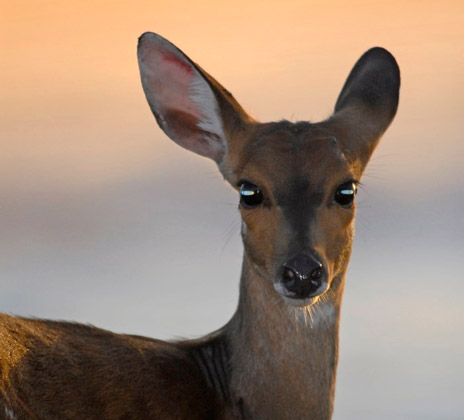
The Menelik’s bushbuck, similar in appearance to common bushbuck, is unique to Ethiopia.
Plan your trip to the Simien Mountains
Getting there
Ethiopian Airlines has regular daily departures from Johannesburg to Addis Ababa. From Addis, it takes up to eight hours by road to travel the 400-odd kilometres to Dinsho, where the Bale Mountains National Park starts. The Simien Mountains are a little shy of 900 kilometres north of Addis, and the going is slow due to an abundance of livestock. It’s best to fly from Addis to the nearest town of Gondar (Ethiopian Airlines has several daily flights) or hire a vehicle and driver who understands how to navigate safely through the goat herds and suicidal pedestrians that populate the roads. Expect to pay around R2000 a day for a robust 4×4 with a driver.
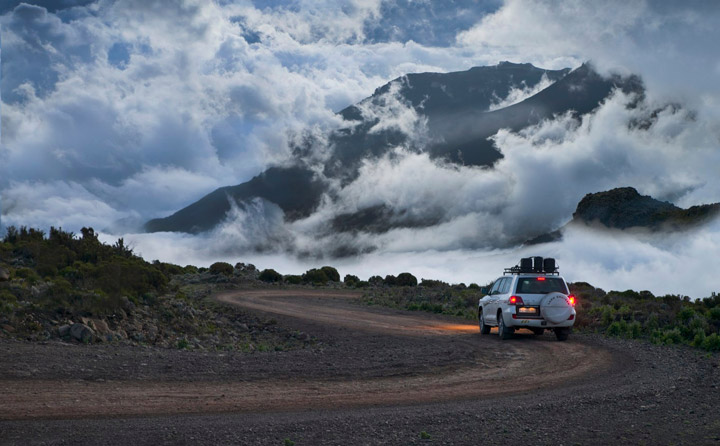
A single gravel road runs through the Bale highlands. It’s a public road and turns into a 4×4 obstacle course during the rainy season and in winter, snow can cut off the area for weeks at a time.
When to visit
I travelled in November and the weather was mostly good but for a few squalls atop the plateaus and highlands. It’s chilly up there no matter what time of year you go. If you visit between October and January, it’s unlikely you will encounter inclement weather or rain. If you don’t mind downpours, the wet season starts in June and extends into August – the landscapes are greener and more vibrant and flowers carpet the highland landscapes, but be warned that mountain roads are easily flooded.
Things to do
There’s no shortage of things to do: wolf-tracking, multi-day horseback camping trails, multi-day mountain hikes, hanging out with geladas, birding and climbing Ras Dashen, Ethiopia’s highest peak at 4550 metres. For specialist wildlife and cultural photographic tours, go to oryxphotography.com; for guided birding trips see rockjumperbirding.com. Visit dinkneshethiopiatour.com for a range of all-inclusive packages.
Travel tips
Pack cold-weather clothing for the highlands. If hiking to the really high peaks such as Ras Dashen, take time to acclimatise. Philip Briggs’s Bradt Guide to Ethiopia is an indispensable source of advice and information – keep updated at bradtethiopiaupdate.wordpress.com.
Where to stay
1. The Bale Mountain Lodge

Bale Mountain Lodge opened its doors in early 2014 and is fast becoming a beacon for tourists wanting to stay in the area.
The Bale Mountain Lodge has a number of simply decorated but luxurious cottages tucked into the Harenna Forest, with superb views over the jungles and up the foothills of the Bale plateau. Ask to be walked through the forest by a guide, who will show you waterfalls, birds and, if you’re lucky, a troop of the rare endemic Bale Mountain vervet monkeys. I alternated my forays between the highland plateau (to see the wolves) and the Harenna Forest.
Cost: From US$290 a person a night sharing, including meals, drinks and one activity daily. balemountainlodge.com
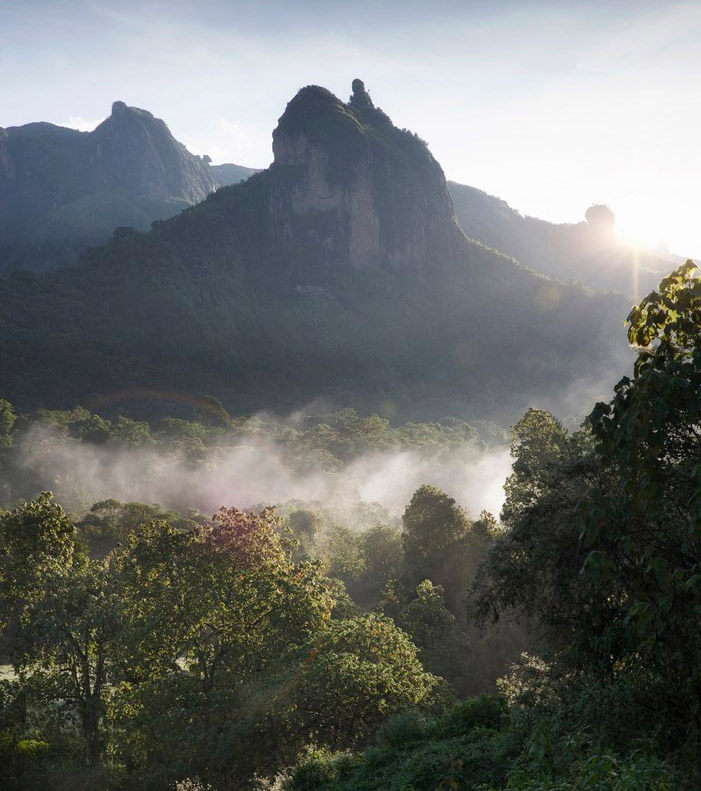
The views from the Bale Mountain Lodge chalets are beautiful, as the Harenna Forest gives way to bamboo forests growing upon the ancient buttresses of the mountains.
2. Simien Lodge
At 3260 metres, Simien Lodge claims to be the highest in Africa, and its spacious and comfy rondavels have underfloor heating to combat the chill. It’s also the only accommodation in the national park itself. The bar (also the ‘highest in Africa’ – the pub in Lesotho that claims the same thing is ‘only’ at 2874 metres) is a great place to sit around a fire and sip a warming whisky or a hot cup of coffee. My fondest memory of Ethiopia is of sitting in the lodge’s restaurant as a troop of some 500 geladas wandered by, peering in at me through the windows. It offers horse trails, guided trips to see the geladas and mountain-biking. I opted for the walking trips, a fantastic way of seeing the region’s wildlife and scenery up close.
Cost: B&B from US$225 a person a night sharing. simiens.com
3. Budget options
If you want to visit Ethiopia on a budget, buy a backpacker guidebook (I recommend Lonely Planet or Bradt). You can probably get by on around R400 a day as long as you stay in cheap grubby hotels, eat in local restaurants and use public buses (which are slower than a snail). Presently, there isn’t much to recommend in terms of mid-range accommodation in the Bale and Simien areas, but this is likely to change as ecotourism becomes more popular.
What to eat and drink
Don’t be shy to try out local establishments in towns and villages. Ethiopian food (and coffee) is great. Even the shabbiest little corner coffee house will serve you a brew that compares favourably to anything you’ve tasted elsewhere – Ethiopia is the birthplace of coffee, after all. Local dishes are spicy (pack medication for stomach upsets, just in case) and often served on a huge injera (pancake) rather than a plate. Both Bale and Simien Lodges provide meals and alcoholic beverages.
This article first appeared in the September 2014 issue of Getaway magazine.









